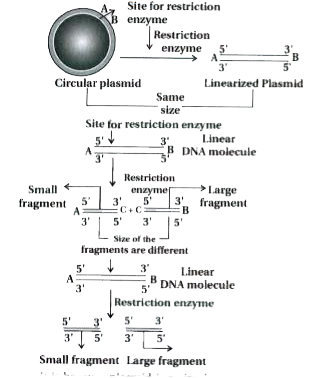A plasmid DNA and a linear DNA (both are of the same size) have one site for a restriction endonuclease. When cut and separated on agarose gel electrophoresis, plasmid shows one DNA band while linear DNA shows two fragments. Explain.

It is because plasmid is a circular DNA molecule.
When cut with enzyme, it becomes linear but does not get fragmented. Whereas, a linear DNA molecule gets cut into two fragments. Hence, a single DNA band is observed for plasmid while two DNA bands are observed for linear DNA in agarose gel.
Topper's Solved these Questions
- BIOTECHNOLOGY : PRINCIPLES AND PROCESSESBOOK - KUMAR PRAKASHANCHAPTER - BIOTECHNOLOGY : PRINCIPLES AND PROCESSESEXERCISE - SECTION - E (SOLUTION OF NCERT EXEMPLAR)(LONG ANSWER TYPE QUESTIONS)
3 Videos
- BIOTECHNOLOGY : PRINCIPLES AND PROCESSESBOOK - KUMAR PRAKASHANCHAPTER - BIOTECHNOLOGY : PRINCIPLES AND PROCESSESEXERCISE - SECTION - F (MULTIPLE CHOICE QUESTIONS (MCQs))
122 Videos
- BIOTECHNOLOGY : PRINCIPLES AND PROCESSESBOOK - KUMAR PRAKASHANCHAPTER - BIOTECHNOLOGY : PRINCIPLES AND PROCESSESEXERCISE - SECTION - E (SOLUTION OF NCERT EXEMPLAR)(VERY SHORT ANSWER TYPE QUESTIONS (VSQs))
10 Videos
- BIODIVERSITY AND CONSERVATIONBOOK - KUMAR PRAKASHANCHAPTER - BIODIVERSITY AND CONSERVATIONEXERCISE - SECTION - F (MCQs A SKED IN COMPETITIVE EXAM)
70 Videos
- BIOTECHNOLOGY AND ITS APPLICATIONSBOOK - KUMAR PRAKASHANCHAPTER - BIOTECHNOLOGY AND ITS APPLICATIONSEXERCISE - Section - F (Multiple Choice Questions (MCQs ASKED IN COMPETITIVE EXAM))
90 Videos
Similar Questions
A plasmid DNA and linear DNA (both are of the same size) have one site for restriction endonuclease. When cut and separated on agarose gel electrophoresis, plasmid shows one DNA band, while linear DNA shows two fragments Explain.
View SolutionA plasmid DNA and linear DNA (both are of the same size) have one site for restriction endonuclease. When cut and separated on agarose gel electrophoresis, plasmid shows one DNA band, while linear DNA shows two fragments Explain.
View Solution
Knowledge Check
Separation of DNA fragments using agarose gel electrophoresis occurs due to:
ADifference in the sequence of the fragmentsBPresence of different charges on the fragments.CDifference in the staining properties of the fragments.DDifference in the sizes of the fragments.A foreign DNA and plasmid cut by the same restriction endonuclease can be joined to form a recombinant plasmid using
APolymerase-IIIBLigaseCEco RIDTaq polymeraseA foreign DNA and plasmid cut by the same restriction endonuclease can be joined to form a recombinant plasmid using :
AEco RIBLigaseCPolymerase IIIDTaq polymerase
A foreign DNA and plasmid cut by the same restriction endonuclease can be joined to form a recombinant plasmid using
View SolutionA foreign DNA and plasmid cut by the same restriction endonuclease can be joined to form recombinant plasmid using
View SolutionA foreign DNA and plasmid cut by the same restriction endonuclease can be joined to form a recombinant plasmid using
View SolutionA foreign DNA and plasmid cut by the same restriction endonuclease can be joined to form a recombinant plasmid using
View SolutionA foreign DNA and plasmid cut by the same restriction endonuclease can be joined to form a recombinant plasmid using
View Solution
